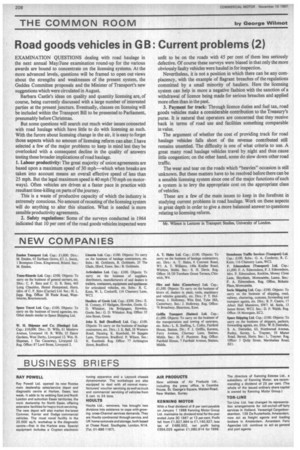Road goods vehicles in GB: Current problems (2)
Page 210

If you've noticed an error in this article please click here to report it so we can fix it.
EXAMINATION QUESTIONS dealing with road haulage in the next annual May/June examination round-up for the various awards are bound to concentrate on the licensing systems. At the more advanced 'levels, questions will be framed to open out views about the strengths and weaknesses of the present system, the Geddes Committee proposals and the Minister of Transport's new suggestions which were circulated in August.
Barbara Castle's ideas on quality and quantity licensing are, of course, being currently discussed with a large number of interested parties at the present juncture. Eventually, clauses on licensing will be included within the Transport Bill to be presented to Parliament, presumably before Christmas.
But some questions will search out much wider issues connected with road haulage which have little to do with licensing as such. With the furore about licensing change in the air, it is easy to forget those aspects which no amount of licensing reform can alter. I have selected a few of the major problems to keep in mind lest they be overlooked with a consequent decline in the quality of answers testing these broader implications of road haulage.
1. Labour productivity: The great majority of union agreements are based upon a maximum speed of 30 mph—which when breaks are taken into account means an overall effective speed of less than 25 mph. But the legal maximum speed is 40 mph (70 mph on motorways). Often vehicles are driven at a faster pace in practice with resultant time-killing on parts of the journey.
This is a waste of productive capacity of which the industry is extremely conscious. No amount of recasting of the licensing system will do anything to alter this situation. What is needed is more sensible productivity agreements.
2. Safety regulations: Some of the surveys conducted in 1964 indicated that 10 per cent of the road goods vehicles inspected were
unfit to be on the roads with 45 per cent of them less seriously defective. Of course these surveys were biased in that only the more obviously faulty vehicles were hauled in for inspection.
Nevertheless, it is not a position in which there can be any complacency, with the example of flagrant breaches of the regulations committed by a small minority of hauliers. Here the licensing system can help in more a negative fashion with the sanction of a withdrawal of licence being made for serious breaches and applied more often than in the past.
3. Payment for track: Through licence duties and fuel tax, road goods vehicles make a considerable contribution to the Treasury's purse. It is natural that operators are concerned that they receive back in terms of road use and facilities something comparable in value.
The argument of whether the cost of providing track for road haulage vehicles falls short of the revenue contributed still remains unsettled. The difficulty is one of what criteria to use. A great many road haulage vehicles travel by night and thus cause little congestion; on the other hand, some do slow down other road traffic.
The wear and tear on the roads which "heavies" occasion is still unknown. But these matters have to be resolved before there can be a sensible licensing system since one of the major functions of such a system is to levy the appropriate cost on the appropriate class of vehicles.
These are a few of the main issues to keep in the forefront in studying current problems in road haulage. Work on these aspects in great depth in order to give a more balanced answer to questions relating to licensing reform.




































































































































































































































































